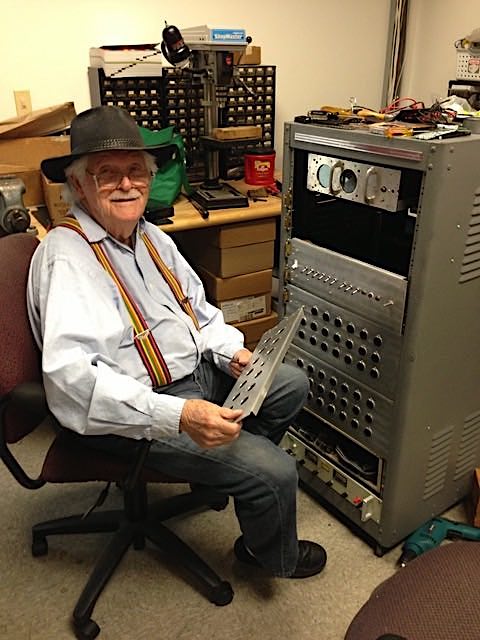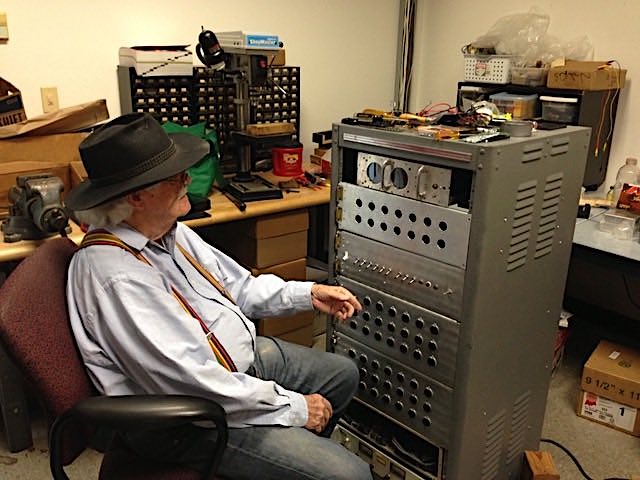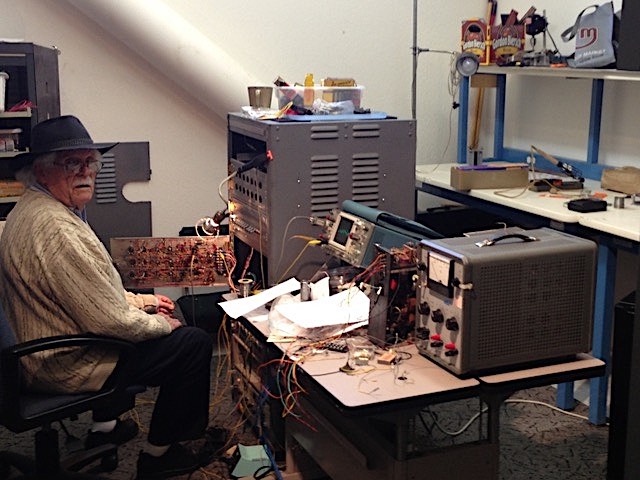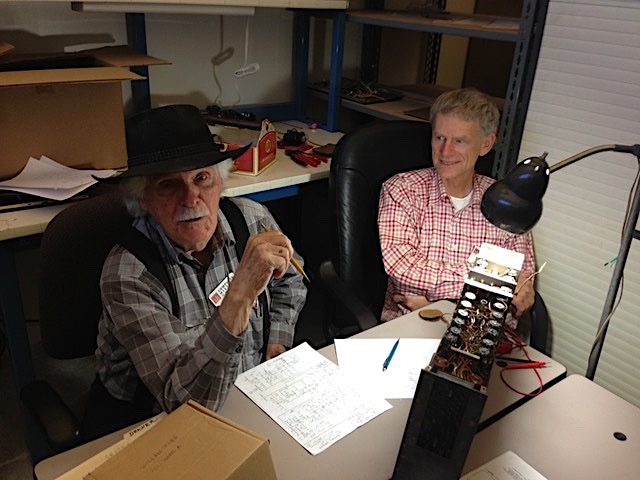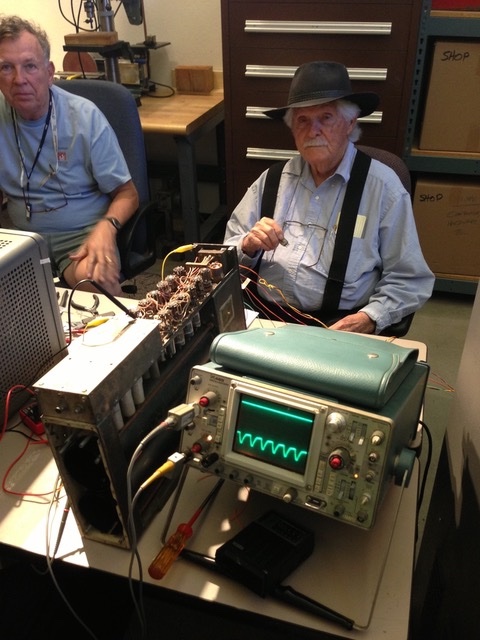Return to Index
Bob Erickson & Williams (-Kilburn) Tube Memory
Started September 20, 2021 - "In Early Development"
- start of a flury of e-mails
Updated through Sept 22, 2021
- enough e-mails to start categorizing them
|
"Executive Summary"
(To be corrected and enhanced)
- In the 1950s, Bob Erickson (an IBM 1401 Restoration volunteer) had maintained an IBM 701.
- IBM 701s used the Williams (-Kilburn) Tube Memory system, used as fast random
access memory for digital computers before the invention
of "Magnetic Core Memory".
- In the 2000s, Bob Erickson was given a two tube chassis from an IBM 701 memory system.
- Bob Erickson started constructing his vision of a demonstration memory system (demo rack)
using this two tube chassis as its heart - but died before completion.
- (September 2012) A person, with an
interesting track record, " ... mentioned that he was interested in getting a Williams Tube working." (It is currently not known if this involves the existing partially
completed demo system
- and/or starting from scratch with a CRT (Williams Tube).
|
New Stuff
Evident Categories as of Sept 22, 2021
Very brief introduction
|
This web page is not a formal part of the 1401 Restoration Web Site.
The first electronic speed computer memory (as opposed to rotational speed of a drum memory
or the re-circulating time of an acoustic delay line memory)
was the "Williams (Kilburn) Tube Memory" developed in England.
see Wikipedia's Williams tube.
A testbed for this technology was the
"Manchester Baby" or more formally "Small-Scale Experimental Machine (SSEM)".
This ran its first program on 21 June 1948
This memory was used in all "high speed" computers until the invention of
coincident current magnetic core memory. (First installation on the Whirlwind machine in the summer of 1953.)
This new magnetic core memory was much more reliable and robust than the Williams Tube Memory
and quickly replaced Williams Tube Memories in many existing machines and all new machines. "Core is King" lasted
two plus decades until replaced by the silicon based large scale integration we are still using
today. Chip memory is so cheap that basically "memory is free", and "lightning fast".
The Williams Tube Memory technology pushed the state of circuits art in its era. Microvolt
transient signals
in an environment of much larger noisy signals. Thousands of volts to drive the CRT tubes,
hundreds of volts of deflection volts to point the electron beam. A real test of circuit
design and shielding.
Oddly, memory parity was not used until the very much more reliable core memories arrived,
where it was hardly needed.
|
Enter the IBM 701 ("Defense Computer") with Williams Tube Memory
A number of computers, world wide, were designed and constructed. Some were "one off" and others
sold and used commercially. The first was a "test bed" for the new "Williams" Tube memory.
(The name "Williams" is the American variant of its more formal "Williams-Kilburn" memory.
The Brits also did the Ferranti Mark 1 and others.
Here is an incomplete list of American machines.
There was also the IAS machine and its code incompatable clones Johnniac, Cyclone, and others.
IBM's "first" commercial scientific computer was the
IBM 701.
The first two pages of this oral history of
J. C. Logue
mention some of the memory development problems
involved with this machine.
To develop aircraft and nuclear devices, high speed computers are extremely useful.
Los Alamos National Lab (nuclear) secured an IBM 701, which required quite a maintenance staff
to keep running usefully. Bob Erickson was one of the IBM maintenance staff.
|
Bob Erickson's involvement with Williams Tube Memory
|
As mentioned in the above section, Bob Erickson help maintain the IBM 701 (using Williams Tube Memory) at Los Alamos.
from Robert Garner - Sept 21, 2021
The serendipitous acquirement of the IBM Williams tube module started in January 2012 when Judith Haemmerle spotted an article on Cnet’s website by its chief editor, Lindsey Turrentine, on the discovery of a 1950s IBM storage module in her grandfather’s “pole barn" near Tracy:
"Antique IBM memory box + math = mind-blowing: CNET Reviews Editor in Chief Lindsey Turrentine finds a 1950s machine component in her grandpa's shed--and discovers anew just how blazingly fast technology has progressed."
http://news.cnet.com/8301-17938_105-57364633-1/antique-ibm-memory-box-math-mind-blowing/
After emailing and talking with Lindsey, Bob Erickson and I were able to speak with her grandfather, Bill “WW" Moore, 89, in October. Bob and Bill had actually overlapped in a several areas at IBM in the 1950s — 701 CEs and RAMAC work in San Jose — but didn't know each other. When I spoke with Bill on March 28, 2013, he indicated that he would like to donate the dual Williams Tube module to Bob’s Williams tube reenactment project at the CHM. On Easter Sunday, 2013, Stan Paddock and Judith picked it up from Lindsey at a home in San Jose.
> - what he intended to do with the demo rack
Bob's plan for the Williams tube rack was toggle switches where one could manually read/write any bit location in a 8x8 array. The control circuits were all tube-based. (Bob didn’t have confidence in transistors... :)
> - current schematics
Bob’s initial schematics are here:
http://ed-thelen.org/comp-hist/EricksonB2011-6.jpg.
More schematics and design notes are stored together with the rack.
In Jan, 2015, Bill Newman had the following thoughts about reinvigorating the project:
"Bob did approve of me using an Arduino. Discussions with Marc Verdiell have led me to believe that Arduino can deliver the needed timing resolution one way or another. And, with enough HV MOSFETs, we could make all its I/O pins look like 6SN7's (~ equiv 12AX7 which I think is what was used originally). I'd follow Bob's specs (e.g. 64 bits, not 1024, and his timing notes). I think all the tech is there and doable. I'd like to see the drawer as functional as it could be. At 16 vacuum tubes it isn't a huge reliability issue. About like a 60's black and white tv. I do put it at 500-1000 hours to first glimmer of working. I think the UI would follow what Bob did originally, but just in software. We might be able to improve a little by a demo that marches different bits through it, for more visual impact (so it would be a bit more than Bob's switch interface)."
...
One thing that still needs to be done is to get the Williams tube face re-metalized (for capacitive detection of the cathode ray beam), which perhaps could be done by his son, Dave Erickson, who has a career in coating optics:
https://www.linkedin.com/in/dave-erickson-8b701693/
Dave retired in May, 2020: "I am now developing instrumentation and sensors for astronomical, optical, atmospheric, and geophysical interests in my home shop.” Previously he did "Remote Controlled Observatory Construction and Operation" and has an large observatory in Kennedy Meadows, southern Sierra Nevada:
http://hbastro.com/index.html
Before that he had a long career in optics, photonics, and lasers.**
"The team successfully developed remarkably low absorption films with single digit part per million performance, suitable for the Space Based Laser Project. This accomplishment led to a contract to build the Large Optic Coating Facility located in our Temecula operation. A parallel project led to a significant product break through with commercial applications to the industrial CO2 laser market with the announcement and production of ultra low absorption MP5 antireflection coatings."
I spoke with Dave back in January, 2020, right before the pandemic ramped up. He said he would be happy to metalize the face of the tube.
I need to get back in touch with him and his sister, Robin, regarding the much postponed memorial 1401 luncheon for Bob and his wife Eileen.
Take care,
- Robert
p.s. I had lent to Bob a small Russian textbook on Williams Tube memory systems, but we’re not sure where it is now…
|
from Robert Garner - Sept 24, 2021 - from "Proceedings of the I.R.E." October 1953
IBM 701 Electrostatic Storage
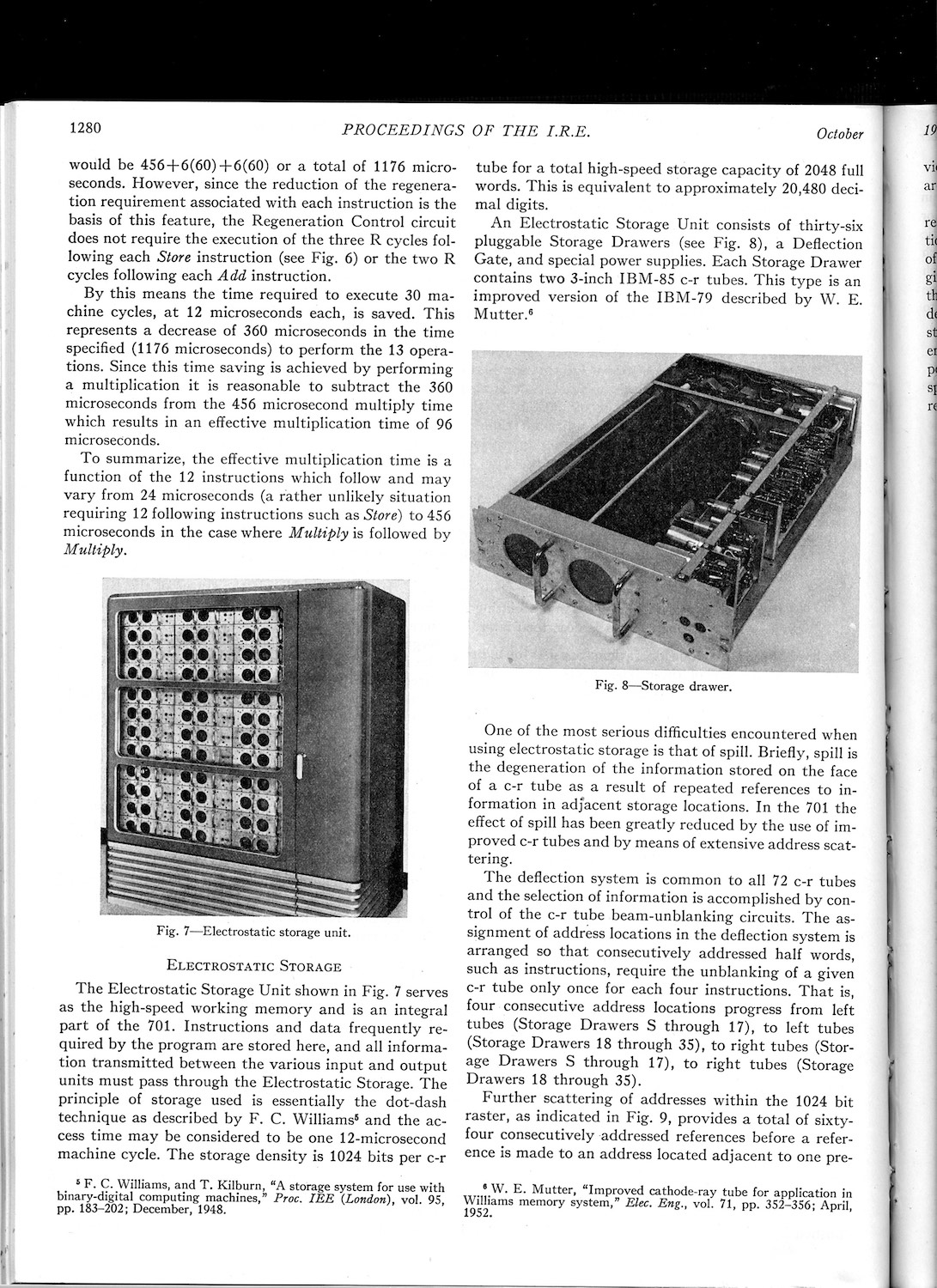
 This was in response to questions, including was the contents of second tube a duplicate of the first?
This was in response to questions, including was the contents of second tube a duplicate of the first?
The author was Frizzell, as in Clarence E. Frizzell.
There is a Youtube series (could use a lot of editing) on the "Development of the IBM 701" including Clarence -
- segment 1 slow start,
- segment 2 components, electrostatic storage - always close to disaster,
drums, (the IBM 650 was 2 years later),
- segment 3 Field Engineering,
- segment 4 NoName machine,
- segment 5 more -
a little tale - in 1980, while feeling prosperous, our family moved to near the top of "Canyon View Drive" in Saratoga, CA.
The neighbor at the top was a friendly old couple, the Frizzells. As I was employed by Measurex, not IBM, we did not talk business.
|
|
Since Bob Erickson's death in December 2013 - not much seems to have been done..
Storage - Newman to "All", Sept 21, 2021 -
All...
Everything is safe and sound. We'll work out a return of the williams tube hardware to the CHM, maybe the week of the 27th. Ed, you should hold off trying to get all the documentation together...its all here with the unit.
Right now, its best to prepare a space in the lab that can accomodate the 4' high rack, adjacent to some bench space for test gear. Even if you don't implement the original 6SN7-based design, you'll most likely need the rack for power supplies etc. I believe Robert has the regulated HV supply (Robert owns it), which will be a required component of the system, along with the tube.
My opinion is to do the support hardware using modern electronics, in particular the deflection D/As, so it will be easy to get the required accuracies.
Bill Newman
|
Storage and potential "un-storage" - Garner to Newman, Sept 21, 2021 -
Bill,
Thanks again for harboring Bob Erickson Williams tube rack at your home!
> We'll work out a return of the williams tube hardware to the CHM, maybe the week of the 27th.
I’m not so sure there’s space in our workshop at this time.
There are two other big beasts in there: 129 keypunch and 557 Interpreter.
One (or both) of these need to be relocated before the Williams tube rack can fit in there.
- Robert
|
Storage and potential "un-storage" - Newman to Garner, Sept 21, 2021 -
Robert...
I need about a one week notice to excavate everything.
To add to your information for Ed... In discussions with Bob, the intent was to coat the front of the tube so that it works as a memory, but not so much that you can't see the 'bits'. Correct me if I'm wrong here, but originally the point of having 2 storage tubes in that memory unit was so that you could see one of them for diagnostic purposes (only one tube had the sheilded pickup on the front, I believe the original pickup you can't see through). There is only one amplifier chain (5 - 6CB6s) in the unit. This setup had the added bonus that if one tube flaked out, you could quickly switch the pickup to the other tube and keep running... but check this statement, I'm unsure of the source! Recall that the sensor plate (which I don't think we ever got) wired through coax to a BNC connector right on the front of the unit.
So with only one tube, we've got to engineer it so you can see the bits! That is, unless CHM would be willing to loan us their Williams tube, so we'd have 2 of them (!) Bob's brother had some great ideas on the subject just before Bob passed, and was pretty confident that we could make something work. Robert, don't worry, I don't think it involved putting anything on your tube, rather it involved fitting a (coated) plastic or glass shape that would be pressure retained on the face of your tube, much like the original pickup.
Bill
|
Storage and potential "un-storage" - Garner to Newman, Sept 21, 2021 -
In September 2021, a glimmer of interest re-surfaced, as follows:
On Sep 19, 2021, at 2:22 PM, Ken Shirriff wrote:
Hi Robert,
I vaguely remember that there was a Williams Tube unit in the 1401 lab. I ran into someone who randomly mentioned that he was interested in getting a Williams Tube working. What is the status of the one in the lab? Is it still around?
Ken
|
Sun 9/19/2021 4:36 PM
from: Ken Shirriff
to:
Eric Schlaepfer
Cc: Bill Newman , ...
Let me introduce Eric Schlaepfer. He mentioned that he wants to get a Williams Tube system working. You may know him from the
MOnSter 6502, a version of the 6502 microprocessor built from discrete transistors, or from his amazing component cross sections.
Robert, Bill, Ed, and Stan are part of the IBM 1401 restoration group at the Computer History Museum.
Ken
| |


